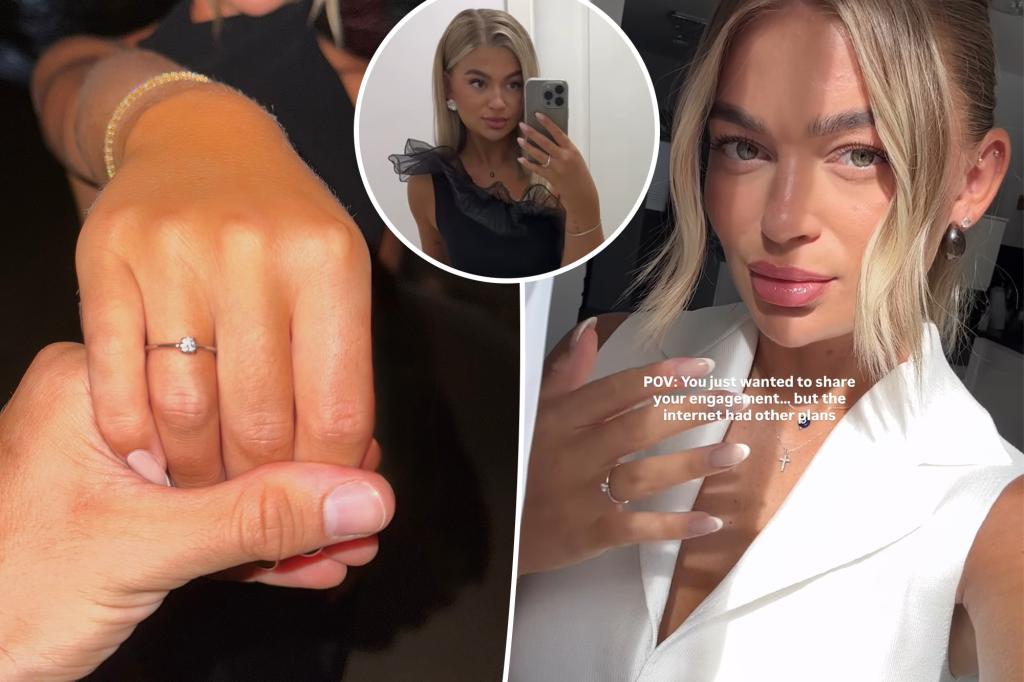A Modest Engagement Ring Sparks Unexpected Controversy
In a world where social media often amplifies extreme displays of wealth and luxury, a German fashion influencer’s simple engagement announcement has unexpectedly thrust her into the spotlight, revealing troubling aspects of our modern attitudes toward love and commitment. Melissa Winkler, who maintains a modest following of around 3,500 on her social platforms, recently shared her joyful news with a photo of her engagement ring, captioning it with the heartfelt sentiment that “forever sounds like paradise.” What should have been a celebration of love quickly transformed into something else entirely as her post went viral, amassing an astonishing 20 million views—not for the happiness it conveyed, but for the contentious debate it sparked about the size of her diamond.
The comment section beneath Winkler’s announcement became a battleground of opinions, with thousands of strangers weighing in on the apparently modest dimensions of her engagement ring. Cruel remarks flooded in, with commenters declaring they “wouldn’t have said yes” to such a proposal or mockingly asking if her fiancé “could not afford a proper ring.” These harsh judgments reflect a disturbing trend that Talitha Cummins, founder of The Cut Jewellery, attributes to shifting cultural expectations around engagement rings. According to Cummins, celebrities like Taylor Swift, with her reported 8-carat diamond, and the increasing accessibility of larger lab-grown diamonds have dramatically altered what people consider acceptable for such an important symbol of commitment. Where once a 3 or 4-carat stone would have been exclusively within reach of the extremely wealthy, these sizes have now become more common benchmarks against which all rings are measured—creating an unrealistic standard that prioritizes size and monetary value over sentiment and personal meaning.
Despite the wave of negativity, Winkler’s post also attracted numerous defenders who appreciated the understated elegance of her ring and what it truly represented. Many commenters expressed fatigue with ostentatious jewelry trends, with one person noting that the ring was “refreshing to see” amid a sea of oversized stones that resemble prizes from “a gumball machine.” Others specifically praised the dainty aesthetic of Winkler’s ring, while some lamented how proposals have transformed from “a celebration of love” into “a statement of wealth.” These supportive voices highlight an important counterpoint to the materialistic critique—that the value of an engagement ring should be measured not by its size or price tag, but by the commitment and love it symbolizes. As one commenter poignantly observed, the backlash to Winkler’s ring sadly confirms that we are “living in such a materialistic world.”
Jewelry expert Cummins echoes this sentiment, expressing disappointment at the tendency to judge engagement rings based on superficial criteria rather than focusing on the meaningful milestone they represent. She argues that the “narrative around ring judgement needs to change,” pointing out that personal preferences vary widely, with many people genuinely preferring more delicate jewelry styles. Moreover, Cummins emphasizes that couples often prioritize other significant life goals—such as buying a home or starting a family—over spending excessively on a ring. Her perspective serves as an important reminder that observers rarely have insight into a couple’s financial circumstances, values, or aesthetic preferences, making such judgments not only unkind but fundamentally misguided. The controversy surrounding Winkler’s ring underscores a troubling disconnect between the authentic meaning of engagement—a promise of commitment and partnership—and the materialistic expectations that have come to overshadow this deeply personal decision.
For her part, Winkler has responded to the unexpected attention with grace and positivity. In a follow-up video showcasing her ring, she acknowledged her surprise at going viral over her engagement but reaffirmed what truly matters: “All I know is I’m happy, I’m grateful & I said YES!!” Her response demonstrates a refreshing clarity about the real significance of her engagement—the commitment to her partner rather than the size of her diamond. While many viewers praised her response and suggested her future husband had “hit the jackpot” with such a level-headed partner, others remained skeptical, questioning whether the entire scenario might be “rage bait” designed to generate exactly this kind of controversial reaction. This cynicism itself speaks volumes about how accustomed we’ve become to manipulation on social media platforms, where authentic moments of joy are often questioned for their sincerity.
The controversy surrounding Winkler’s engagement ring coincides with significant shifts in the diamond industry itself. Lab-grown diamonds, which typically cost 40 to 50 percent less than their earth-mined counterparts, now comprise approximately 35 to 40 percent of diamond sales in Australia. This technological development has democratized access to larger stones, potentially fueling the trend toward bigger engagement rings that Cummins identified. Yet the debate sparked by Winkler’s modest ring suggests that perhaps we’re reaching a cultural inflection point—a moment to reconsider what these symbols truly mean and whether the pressure to conform to increasingly extravagant standards serves anyone well. As wedding costs continue to rise and young couples face unprecedented financial challenges including housing affordability crises and economic uncertainty, perhaps there’s wisdom in reconsidering what truly matters when building a life together. Winkler’s story, though unexpected in its viral reach, offers a valuable opportunity to reflect on our values and whether a return to celebrating love itself, rather than its material trappings, might be the most precious trend of all.


